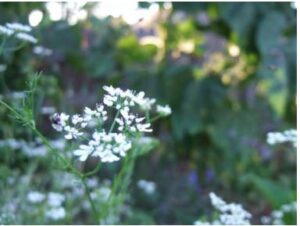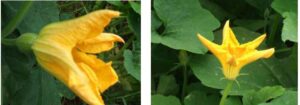Easy-From-Seed : Edible Flowers
Edible Flower Quiz – Most gardeners know that nasturtiums add a radishy kick to salads. And foodies appreciate the delectable texture and taste of battered and fried squash blossoms. But nasturtiums and squash blossoms are just two of dozens of flowers that go from seed to salad in a matter of weeks. Take this quiz to find out how much you do, or don’t know about the edible flowers in your garden:
| ONE OF THE FOUR STATEMENTS ABOUT EACH VARIETY IS NOT TRUE. WHICH IS IT? (Answers follow the quiz) 1. Scarlet runner bean (Phaseolus coccineus) flowers 2. Anise hyssop (Agastache foeniculum) 3. Borage flowers (Borago officinalis) 4. Calendula (Calendula officinalis) flowers |
Quiz Answers:
- d. Scarlet runner bean is actually a perennial plant in its native Mexico. Other parts of the plant (in addition to the beautiful red flowers) are also edible: the dried bean, the young pods, and even the starchy root.
- c. Anise hyssop is generally avoided by deer. Use this to your advantage by planting a border of it around your garden.
- b. Although borage leaves have a pronounced cucumber flavor, the taste of the flowers is so delicate it is hard to define—mildly sweet and oh-so-slightly peppery.
- d. Scarlet runner bean is actually a perennial plant in its native Mexico. Other parts of the plant (in addition to the beautiful red flowers) are also edible: the dried bean, the young pods, and even the starchy root.
The Easiest of the Easy
The variety of edible flowers you can grow in your garden is likely more extensive than you realize. And isn’t it fortunate that many of them can be grown easily from seed? With fragile flowers, freshness is imperative. They do not store well, which explains why they are so expensive at the market. Plan to integrate a few into your landscape next season, and the payback will be threefold: color on your plate, taste on your tongue, and beauty in your garden.

How can I tell which flowers are edible?
Not by taste testing, that’s for sure! Consult a reliable source—a university website or a trusted non-profit organization (such as the Home Gardening Seed Association), for example—before popping petals into your mouth. Generally, flowers of edible herbs are tasty and non-toxic.
Which edible flowers are the easiest to grow from seed?
There’s a sizable list of plants that, sown directly in the garden, yield edible flowers that same season. It doesn’t get much easier than that! Prepare the soil by loosening it and adding compost. Sow seed and cover the seedbed lightly with soil.HGSA recommends the following Top Ten for reliability, fast results, and flavor: Sow in early spring: arugula, bachelors’ button, calendula, cilantro, Johnny-jump-up Sow when the soil warms and night temperatures are above 50ºF: borage, nasturtium, scarlet runner bean, signet marigold, squash.
Where can I fit these edible flowers in my crowded garden?
Be creative in finding appropriate niches for these beauties. Where there’s a will, there’s a way! Runner beans are best grown vertically, on an obelisk or trellis. Sow cilantro and bachelors’ buttons in spaces where bulbs have died back, and borage in areas vacated by spring greens. Many smaller edible flowers, such as calendula, Johnny-jump-ups, nasturtiums, and signet marigolds, are well suited for container growing. Use a generoussize container so that you will not have to be a slave to its needs in the heat of summer. As for the squash, the space hog, set aside a 3 x 3 foot space for arugula, and follow it with a hill of summer squash (two plants) for a good yield of greens, arugula flowers, squash blossoms, and a summer’s worth of fruit as well.


| Common name |
Scientific name | Flavor | Comments |
|---|---|---|---|
| Anise hyssop | Agastache foeniculum |
Sweet anise-like flavor | Plants attract many different pollinators |
| Arugula | Eruca vesicaria sativa |
Nutty, spicy, peppery flavor – like the leaves |
Leaves turn bitter when flowers form |
| Bachelors’ Buttons |
Centaurea cyanus |
Mild, slightly sweet to spicy |
Most often used as a garnish |
| Borage | Borago officinalis |
Very mild flavor | Carefully separate the blue flower from its stem |
| Calendula | Calendula officinalis |
Tangy and slightly peppery |
Petals lend a yellow hue to cooked foods |
| Chives, Garlic | Chives Alliums spp. |
Oniony and very flavorful | Clip garlic chive flowers to avoid self-sowing |
| Cilantro | Coriandrum sativum |
Pungent and flavorful— like the leaves |
Cilantro flowers make a nice guacamole garnish |
| Lavender | Lavandula spp. | Floral, slightly perfumey flavor |
Intense flavor; use sparingly |
| Marigold | Tagetes tenuifolia |
Flowers smell and taste citrusy |
Low mounding plants make a beautiful border |
| Nasturtium | Tropaeolum majus |
Peppery, spicy, delicious! | Entire flower can be eaten, also the leaves and green seedpods. |
| Okra | Abelmoschus esculentus |
Very mild flavor | Flowers are big and beautiful and can be used cooked or raw. |
| Peas, edible | Pisum sativum | Pea-like flavor | Do not eat sweetpeas (Lathyrus latifolius) |
| Scarlet Runner | Phaseolus coccineus |
Sweet bean flavor | Beautiful vines need a fence or trellis |
| Squash | Cucurbita pepo | Soft texture, mild flavor | Both male and female blossoms can be used |
| Viola | Viola tricolor | Mild pea-like flavor | Candied or used fresh in salads or as a garnish |
